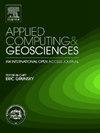Automatic seismic fault detection and surface construction
IF 3.2
Q2 COMPUTER SCIENCE, INTERDISCIPLINARY APPLICATIONS
引用次数: 0
Abstract
This paper proposes an effective approach for automatically building the fault model based on the 3D seismic images via two steps of automatic seismic fault detection and fault surface construction. Automatic seismic fault detection is performed to automatically classify the seismic image into two phases of fault and background using a slightly revised deeplabv3_resnet50 architecture with pretrained parameters provided by PyTorch. The output of the automatic seismic fault detection is a binary image contains fault and background, where one fault may be separated into different fault segments, or several faults are connected with each other which need further distinguish. To reassemble these detected fault segments and construct the fault surface model, four steps are implemented including:1) a morphological workflow is used to separate all connected faults into separated fault segments; 2) the moving least square (MLS) method is used to fit each fault segments as a smooth, one-voxel thickness surface; 3) the weighted principle component analysis (WPCA) method is applied to calculate the normal vector of each surface voxel to judge whether two or more adjacent segments should be combined in one fault surface; 4) MLS method is applied again to fit all surface segments from one fault as an unique fault surface. The final output of the proposed method provides a fault model with well-defined, cleanly separated, labeled fault surfaces that is competent for structure modelling.
自动地震断层检测和地表施工
本文提出了一种基于三维地震图像自动建立断层模型的有效方法,该方法分为地震断层自动检测和断层表面构造两个步骤。使用PyTorch提供的预训练参数,使用稍微修改的deeplabv3_resnet50架构进行自动地震故障检测,将地震图像自动分类为故障和背景两个阶段。地震断层自动检测的输出是包含断层和背景的二值图像,其中一个断层可能被分割成不同的断层段,或者几个断层相互连接,需要进一步区分。为了对检测到的故障段进行重组并构建故障面模型,实现了四个步骤:1)使用形态学工作流将所有连接的故障分离成独立的故障段;2)采用移动最小二乘(MLS)方法拟合各断层段为光滑的单体素厚度面;3)采用加权主成分分析(WPCA)方法计算每个面素的法向量,判断是否需要在一个断层面上合并两个或多个相邻的断层段;4)再次应用MLS方法拟合一个断层的所有面段作为唯一的断层面。该方法的最终输出提供了一个断层模型,该模型具有定义良好,分离清晰,标记的断层面,可用于构造建模。
本文章由计算机程序翻译,如有差异,请以英文原文为准。
求助全文
约1分钟内获得全文
求助全文
来源期刊

Applied Computing and Geosciences
Computer Science-General Computer Science
CiteScore
5.50
自引率
0.00%
发文量
23
审稿时长
5 weeks
 求助内容:
求助内容: 应助结果提醒方式:
应助结果提醒方式:


